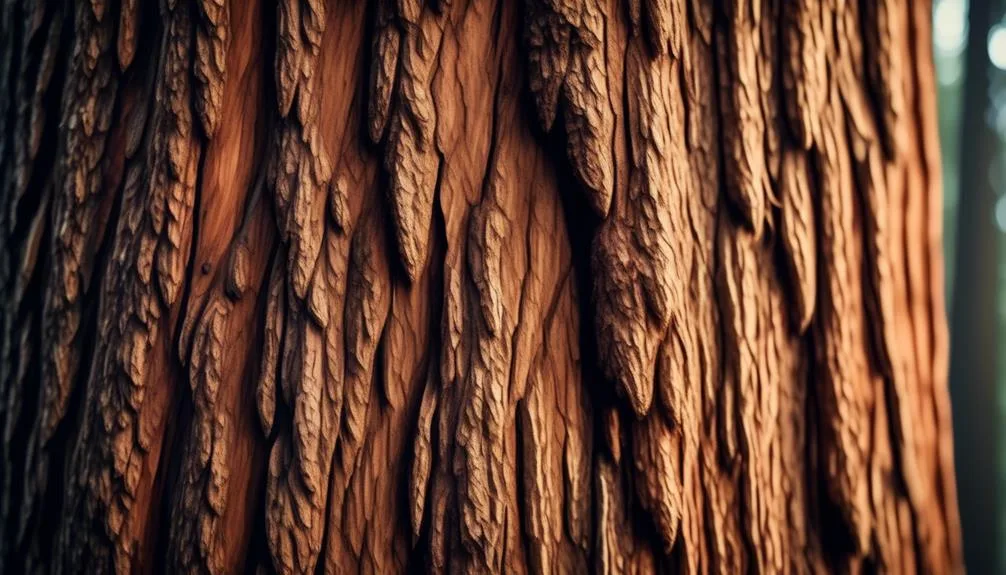Discovering the differences among the three types of redwood trees can be an exciting journey. Each species has its own unique traits and can be found in specific areas. If you've ever been amazed by the beauty of redwood trees and wanted to distinguish them, you're in the right place.
By observing their physical characteristics and understanding their natural habitats, you can learn to tell apart coast redwoods, giant sequoias, and dawn redwoods.
Let's explore the distinctive features of each redwood species.
Physical Characteristics of Redwood Tree Species
When identifying redwood tree species, it's important to observe their physical characteristics such as bark texture, leaf shape, and cone size to distinguish between them accurately.
Redwood tree bark texture varies between species, with the coast redwood having thick, fibrous bark and the giant sequoia having soft, spongy bark.
Additionally, leaf shape is a key distinguishing factor, where the coast redwood has small, flat, and linear leaves, while the giant sequoia has smaller, scale-like leaves arranged in spirals.
Geographic Distribution of Redwood Tree Species
The geographic distribution of redwood tree species varies significantly, with the coast redwood primarily found along the coastal regions of northern California and the giant sequoia predominantly thriving in the western slopes of the Sierra Nevada mountains. Understanding the geographic distribution of these magnificent trees provides insight into their specific climate requirements and habitat diversity.
Coastal Majesty: The coast redwood stands tall along the misty and foggy coastal areas, creating a sense of awe and tranquility.
Mountain Monarchs: Giant sequoias command attention as they majestically stand amidst the rugged terrain of the Sierra Nevada mountains, inspiring feelings of strength and resilience.
Climate Harmony: These trees thrive in the cool, moist climate of the coast redwood forests and the drier, warmer climate of the giant sequoia groves, evoking a sense of adaptability and endurance.
Diverse Habitats: From the lush coastal forests to the rugged mountain landscapes, these redwood species showcase the diverse beauty of nature, stirring emotions of wonder and appreciation.
Identifying Features of Coast Redwood Trees
Nestled within the coastal forests of northern California, you can easily identify coast redwood trees by their towering height and reddish-brown fibrous bark.
The bark of coast redwoods is thick, fibrous, and deeply furrowed, providing the tree with fire resistance and protection from fungal diseases.
Their leaves are flat, needle-like, and arranged in two opposite rows, giving the foliage a feathery appearance. The leaf shape is lanceolate, with a green hue that turns yellow in the fall before shedding. Additionally, the leaves release a pleasant, distinctive aroma when crushed or brushed against.
These identifying features—distinctive bark and flat, needle-like leaves—make it relatively straightforward to differentiate coast redwood trees from other species in their natural habitat.
Distinguishing Traits of Giant Sequoia Trees
Amidst the coastal forests of northern California, you can readily distinguish the towering coast redwood trees by their reddish-brown fibrous bark and feathery foliage; pivoting from these identifying features, the giant sequoia trees exhibit their own distinguishing traits.
- Giant Sequoia Size: These colossal trees can reach astonishing heights of over 300 feet, making them some of the largest living organisms on Earth.
- Bark Patterns: Unlike the coast redwoods, giant sequoias have a unique cinnamon-red, fibrous, and spongy bark that acts as a natural fire repellent.
- Tree Ring Analysis: By studying the tree rings, scientists can unravel the environmental history and provide insights into the tree's age and past conditions.
- Environmental Adaptations and Conservation Efforts: Giant sequoias have adapted to withstand wildfires, and ongoing conservation efforts aim to protect these majestic trees from environmental threats.
These distinguishing traits showcase the remarkable characteristics and significance of giant sequoia trees.
Tips for Identifying Dawn Redwood Trees
With its delicate, fern-like foliage and red-brown peeling bark, the dawn redwood tree can be identified by its distinctive features. When identifying dawn redwood trees, pay attention to the texture of the bark and the shape of the leaves. The bark of a dawn redwood tree is fibrous and peels off in long, vertical strips. This distinct bark texture sets it apart from other redwood tree species. Additionally, the leaves of the dawn redwood tree are feather-like and arranged in two ranks, resembling the shape of a flattened spray of a feather. Here's a table to summarize the key identifying features:
| Feature | Description |
|---|---|
| Bark Texture | Red-brown, fibrous, peeling in strips |
| Leaf Shape | Delicate, fern-like, flattened spray |
Conclusion
In the diverse world of redwood trees, each species holds its own unique characteristics waiting to be discovered.
Next time you wander through the forest, take a moment to observe the tall, straight trunks of the coast redwood, the majestic size and cinnamon-colored bark of the giant sequoia, and the delicate, deciduous foliage of the dawn redwood.
Embrace the wonder of nature's diversity and the beauty it brings to our surroundings.

My interest in trees started when I first saw the giant sequoias in Yosemite.
I was a teenager then, and I remember thinking, “I need to learn more about this.”
That moment stuck with me.
A few years later, I went on to study forestry at Michigan Tech.
Since graduating, I’ve worked in a mix of hands-on tree care and community education.
I’ve spent over ten years helping people understand how to plant, maintain, and protect the trees in their neighborhoods.
I don’t see trees as just part of the landscape.
They are living things that make a real difference in our daily lives.
